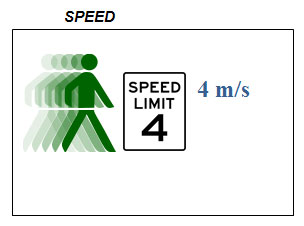The study of the motion of an object is called kinematics. In the following section, you will briefly review these concepts.
![]() Distance is the measurement of the actual path traveled, while displacement is related to how far an object traveled from the original location. The following video clip shows examples of these two concepts.
Distance is the measurement of the actual path traveled, while displacement is related to how far an object traveled from the original location. The following video clip shows examples of these two concepts.
Source: Distance vs. Displacement. in CryEngine 2, Thomas Altman, YouTube
Look at the following images. One shows speed and one shows velocity. What is the difference between these images?

Source: Walking person, Manuel Strehl Wikimedia Commons

Source: Speed Limit Sign, Wikimedia Commons
![]() Remember that speed and velocity are related. Speed is the foundation for understanding velocity. Velocity is a vector and has a magnitude and direction. Watch the following video to refresh your memory about speed and velocity.
Remember that speed and velocity are related. Speed is the foundation for understanding velocity. Velocity is a vector and has a magnitude and direction. Watch the following video to refresh your memory about speed and velocity.
Source: Speed vs. Velocity, Screencasts100, YouTube
The following are three main types of velocity:
The following table will assist you with the difference between these three types of velocity.
Average Velocity |
Instantaneous Velocity |
Constant Velocity |
Average of the displacement of an object over a given amount of time Example: When a car moved 50 km in 2 hours, the average velocity is 25 km/h. |
Velocity of a moving object at a particular instant in time Example: When you are driving a car and its speedometer swings to 50 km/h, then the instantaneous velocity of the car is 50 km/h. |
Velocity that is not changing; no acceleration Example: When a car is parked in the driveway and is not moving, it has a velocity of 0 km/h. |
![]() Finally, let's look at acceleration. The following video will first review some of the concepts you have seen so far. It will then discuss acceleration. After viewing, record in your notes information you learn about acceleration.
Finally, let's look at acceleration. The following video will first review some of the concepts you have seen so far. It will then discuss acceleration. After viewing, record in your notes information you learn about acceleration.
Source: Acceleration, Brian Swarthout, YouTube
Uniform acceleration, sometimes discussed as constant acceleration, is a special type of acceleration. Uniform acceleration is when the speed of an object changes at the same rate. An example of uniform acceleration is gravity. The constant or uniform acceleration on an object due to gravity is 9.8 m/s2. This means that an object falling off of a building is falling at a constant, or uniform, acceleration of 9.8 m/s2.
Now that you have had an opportunity to get to know a few key concepts related to motion, in the upcoming sections, you will look more deeply at the study of the motion of objects, or kinematics. You will start by looking at the language of kinematics.